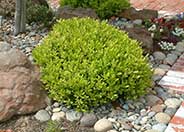
Common name:Australian Willow
Botanical name:Geijera parviflora
Australian Willow (Geijera parviflora) is an excellent specimen tree for medium-sized gardens. This Australian native tree reaches 45’ tall and 20’ wide and is very low-water-use and low maintenance. These trees can be found in nurseries in both single-trunk and multi-trunk forms. The natural growth habit is weeping and irregular, so it does require some selective pruning and shaping when young to achieve the desired look. Thinning out the heavy, weeping branches will take some of the weight out of them, and they usually lift. The tree may require this type of pruning a few times a year for the first two or three years, but once it has achieved a height requiring a ladder to prune, it should be shaped by a licensed arborist. This tree is a slow grower and would benefit from an application of nitrogen fertilizer every year. It should be planted at least four feet away from any hardscape areas, 15 feet from structures such as houses and buildings, and not near any powerlines. Shrubs and perennials should be planted about three feet away from this tree. It should be irrigated for about 45 minutes once a week when using most in-line drip irrigation systems.

Common name:Kleinia
Botanical name:Senecio mandraliscae
This succulent perennial will grow to about 1.5' tall and 2' wide. It has curved, bluish gray leaves that are about 3.5" long and very slender.

Common name:Wheeler's Dwarf Pittosporum
Botanical name:Pittosporum tobira 'Wheeler's Dwarf'
This handsome dwarf form of the Pittosporum tobira grows into a low, dense mound that is covered with glossy, evergreen foliage.
Designer: Rob Moore
Photographer: GardenSoft
Practice grass-cycling by leaving short grass clippings on lawns after mowing, so that nutrients and organic matter are returned to the soil.
Mulching and adding compost to soil can minimize evaporation and help soil absorb and store water.
Attract, or buy beneficial insects such as ladybugs and lacewings to control pest outbreaks in your garden.